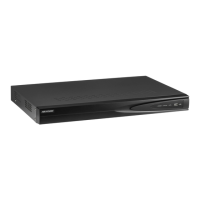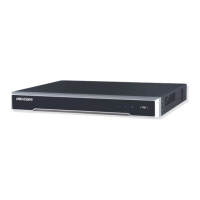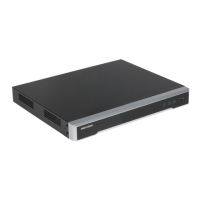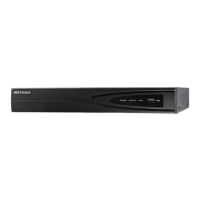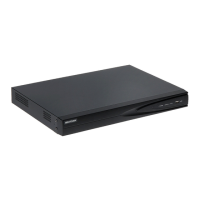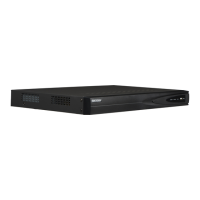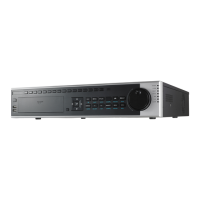Do you have a question about the HIKVISION DS-7616HI-ST and is the answer not in the manual?
Overview of general capabilities and connectivity options for network cameras and encoders.
Capabilities for simultaneous HDMI, VGA, and CVBS video outputs and live view options.
Options for connecting and managing SATA hard disks and network storage.
Functionality for setting recording schedules and types, and playback operations.
Methods for exporting and backing up video data via USB or SATA devices.
Configuration for alarm triggers like motion detection and system exceptions.
User management, alarm control, and device configuration file import/export.
Connectivity features including network interface, protocols, and remote access.
Availability of SDK for Windows and Linux, and application software support.
Description of the device's front panel and its indicator lights and interfaces.
Detailed explanation of buttons and functionalities of the infrared remote control.
Guide on connecting and using a USB mouse for navigation and control.
Explanation of the on-screen keyboard icons and their functions.
Identification and description of all connectors and ports on the rear panel.
Procedures for properly powering the device on, shutting it down, and rebooting.
Step-by-step guide for initial device setup through the configuration wizard.
Process for adding online IP cameras automatically or manually to the device.
Steps for editing parameters and settings of already added IP cameras.
Overview of the live video display and its status icons.
Description of functions like single screen, multi-screen, and auto-switch.
Customizing video output, dwell time, and camera order for live view.
Steps to log out of the system interface and return to live view.
Setting up parameters like Baud Rate and PTZ Protocol for camera control.
Creating and configuring camera presets, patrol paths, and movement patterns.
Description of icons and controls within the PTZ panel interface.
Setting stream type, resolution, bitrate, and pre/post-record times.
Setting up continuous, motion, or alarm-based recording schedules.
Setting up motion detection areas, sensitivity, and trigger actions.
Configuring recording to start based on external alarm inputs.
Instructions for manually starting and stopping recording sessions.
Setting up specific recording schedules for holiday periods.
Enabling redundant recording for enhanced data safety and reliability.
Organizing HDDs into groups and assigning channels for recording.
Methods to protect recorded files by locking or setting HDD to read-only.
Accessing and reviewing recorded video footage by channel or time.
Retrieving and viewing recordings based on specific dates and times.
Searching and playing back recordings triggered by specific events like alarms.
Using video tags to search and locate specific video segments.
Finding and playing back recordings linked to system log entries.
Playing back video files stored on external storage devices.
Additional playback features like frame-by-frame, digital zoom, and smart search.
Procedures for exporting and saving recorded video data via various devices.
Operations for managing connected backup storage devices like USB drives.
Configuring motion detection areas, sensitivity, and trigger actions.
Handling and configuring external sensor alarms connected to the device.
Setting up alerts and responses for video signal loss detection.
Configuring detection and alerts for video tampering events.
Managing and configuring responses for various system exceptions like HDD full.
Defining actions taken when an alarm or exception occurs (e.g., full screen).
Manually activating or deactivating alarm outputs for testing or control.
Basic network configuration like IP address, subnet mask, and DNS settings.
Advanced network configurations including PPPoE, DDNS, and UPnP.
Monitoring network data flow, linking status, and sending/receiving rates.
Tools for testing network delay, packet loss, and checking network status.
Steps to prepare new hard disk drives for use by initializing them.
Adding and configuring NAS or IP SAN storage as network HDDs.
Organizing multiple HDDs into groups for storage and recording management.
Allocating specific storage quotas for individual cameras on the HDDs.
Verifying the operational status and health of installed hard drives.
Accessing self-monitoring data for HDD reliability and anticipating failures.
Scanning HDDs for defective sectors to check their condition.
Setting up alarms for HDD errors or abnormal status.
Adjusting on-screen display elements like date, time, and camera names.
Setting up zones to mask sensitive areas in live video feeds.
Adjusting image settings like brightness, contrast, and saturation.
Accessing details about the device, cameras, records, alarms, and network.
Finding and exporting system event and operational logs.
Backing up and restoring device configuration settings.
Procedures for updating the device firmware via local or FTP methods.
Resetting the device to its factory default configuration.
General device configuration for display standards, resolution, and language.
Setting up Daylight Saving Time adjustments for accurate timekeeping.
Additional miscellaneous settings for device name, output modes, and auto-logout.
Creating, editing, and deleting user accounts and their permissions.
Procedures for exiting the system, powering down, or restarting the device.
Definitions of technical terms and acronyms used throughout the manual.
Catalog of Hikvision and third-party IP cameras compatible with the device.
Detailed list of third-party IP cameras and their compatibility information.
Steps to resolve issues with no video output on the connected monitor.
Troubleshooting steps for the audible warning sound indicating HDD issues.
Resolving issues where IP cameras show a disconnected status.
Solutions for frozen video feeds during local output.
Troubleshooting steps when no record files are found during search.
| Video Input | 16 channels |
|---|---|
| Dual Stream | Yes |
| Consumption | ≤ 20W |
| Operating Humidity | 10% to 90% |
| Video Output | HDMI, VGA |
| Compression Format | H.264, H.265 |
| Network Interface | 1 RJ45 10M/100M/1000M adaptive Ethernet interface |
| Power Supply | AC 100-240V, 50/60Hz |
| Audio Output | 1 channel, RCA |
| Remote Connection | Yes |
| USB Interface | 2 x USB 2.0 |
| Power Consumption | ≤20W (without HDD) |
| Operating Temperature | -10°C to +55°C (14°F to 131°F) |
| Weight | ≤3.5kg (without HDD) |


